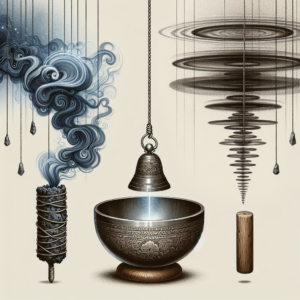When you’re considering the vast landscape of wellness, remote healing sessions might emerge as a unique and somewhat mystical option. With the world becoming increasingly digital, it’s natural to question if the healing touch can transcend physical boundaries. Here, we’ll delve into the concept of remote dowsing, its effectiveness, and how you can leverage it for your well-being.

Imagine being able to receive healing energy from halfway across the globe, feeling a sense of relief and balance without ever leaving your home. This is the promise of remote healing sessions, a practice that has gained attention and curiosity in recent times.
Key Takeaways
- Remote healing, also known as distance healing, is a practice where healing energy is sent across space and time.
- Studies suggest remote healing can be effective in reducing pain, anxiety, and fatigue, particularly in individuals undergoing cancer treatment.
- There are various techniques and tools used in remote healing, including Reiki, chakra balancing, and aura cleansing.
- Preparation and aftercare are important to maximize the benefits of remote healing sessions.
- Selecting the right practitioner is crucial; credentials, testimonials, and personal rapport should be considered.
Exploring the World of Remote Healing
The Fundamentals of Remote Dowsing
Remote dowsing, often interchanged with terms like ‘distance healing’ or ‘remote healing’, is a practice rooted in the belief that energy is not confined by physical space. Practitioners of this art form claim they can tap into a universal energy field to send healing vibrations to anyone, anywhere in the world.
How is this possible? Well, if we consider that everything is energy – a concept supported by physics – the idea that one’s intention can influence another’s energy field starts to seem less far-fetched. Most importantly, it’s a practice that’s all about intention, focus, and connection, despite the absence of physical proximity.
How Does Remote Healing Work?
The process typically begins with the healer and the recipient agreeing on a specific time for the session. During this time, the recipient is encouraged to lie down in a quiet space, open to receiving the healing energy. The healer then enters a meditative state, often visualizing the recipient and channeling healing intentions towards them.
But how can you tell if it’s working? Some recipients report sensations such as warmth, tingling, or a sense of calm and relaxation. Others may notice a gradual improvement in their physical or emotional ailments over time. And some may not feel anything at all during the session, yet still experience positive shifts afterwards.
Real-World Outcomes of Remote Healing
Let’s talk about what really matters—the results. There are countless stories of individuals who’ve experienced profound changes through remote healing sessions. For instance, some cancer patients who’ve incorporated distance Reiki into their treatment plan have reported significant reductions in pain and anxiety. It’s these kinds of stories that fuel the intrigue around remote healing practices.
Case studies and success stories
Consider Jane, a 45-year-old woman dealing with chronic back pain. After several remote healing sessions, she noticed not only a decrease in pain but also an improvement in her overall mood and energy levels. Or take Michael, who struggled with anxiety and found that distance healing sessions helped him to feel more grounded and less overwhelmed by his stressors.
Michael’s story is a testament to the power of remote healing. He shared, “At first, I was skeptical, but after a few sessions, I started to notice a change. I felt more at peace and in control of my anxiety. It’s been a game-changer for me.”
Understanding the limitations and challenges
While success stories are compelling, it’s crucial to approach remote healing with realistic expectations. Healing is a highly individual process, and what works for one person may not work for another. There’s also the matter of finding a reputable practitioner and ensuring you’re both a good fit for each other—more on that later.
Another challenge is the lack of regulatory standards in the field of remote healing, which means it’s up to you to do your due diligence when choosing a practitioner. And, of course, remote healing should not replace conventional medical treatment but rather serve as a complementary approach.
Lastly, because the effectiveness of remote healing can be subjective, some individuals may not feel an immediate or noticeable impact. This doesn’t necessarily mean the session wasn’t beneficial—it could be that the effects are subtle or will reveal themselves over time.
How to Enhance Your Remote Healing Experience
Getting the most out of your remote healing sessions involves more than just showing up. There are steps you can take to enhance the experience and potentially increase its effectiveness.
Preparing mentally and physically for a session
Before your session, find a quiet and comfortable space where you won’t be disturbed. Set the scene with soft lighting, perhaps some candles, and if you like, gentle music. Make sure you’re in a comfortable position, lying down is often recommended, and take a few deep breaths to center yourself.
It’s also helpful to set an intention for what you’d like to receive from the session. Are you looking for pain relief, emotional healing, or perhaps spiritual growth? Communicate this with your healer before you begin.
Aftercare and maintaining benefits post-session
After a remote healing session, it’s important to give yourself some time to integrate the experience. Drink plenty of water, rest if you feel the need, and allow yourself to process any emotions or sensations that arose during the session.
Maintaining a journal can be a great way to track your progress and reflect on any changes you notice over time. You may also want to engage in gentle activities that support your healing process, such as walking in nature, practicing mindfulness, or doing gentle stretches.
Finding the Right Remote Healing Practitioner
Now, let’s address one of the most critical aspects of remote healing: finding the right practitioner. With the internet at your fingertips, you have access to healers from around the world. But with so many options, how do you choose?
- Check their credentials: Look for certifications, training, and experience in their field.
- Read testimonials: What have others said about their experience with the healer?
- Initial consultation: Many healers offer a free initial consultation. Use this opportunity to ask questions and gauge whether you feel comfortable with them.
- Personal rapport: Healing is personal, so it’s important that you feel a sense of trust and connection with your healer.
Finding the right practitioner is about more than just their skill set—it’s also about finding someone who resonates with you and your healing journey. Take your time, listen to your intuition, and choose someone who makes you feel seen and supported.
Criteria for selecting a distant healer
When you’re looking for a distant healer, consider the following criteria:
- Specialization: Do they specialize in the type of healing you’re seeking?
- Approach: What is their healing philosophy, and does it align with your values?
- Availability: Can they accommodate your schedule and time zone?
- Cost: Is their pricing transparent and within your budget?
- Privacy: Do they have a clear privacy policy to protect your personal information?
Remember, the goal is to empower your wellness choices. Remote healing sessions can be a valuable tool in your self-care arsenal, but they require both openness and discernment. By understanding the process, setting the stage for success, and choosing the right practitioner, you’re taking active steps toward your own healing and well-being.
Questions to ask a potential remote healing provider
Before committing to a remote healing provider, it’s wise to have a conversation that could provide clarity and confidence in your choice. Start with questions that will help you understand their experience and methods:
- Can you explain your remote healing process and what techniques you use?
- How long have you been practicing, and what training have you received?
- What kind of feedback do you typically receive from clients?
- How do you personalize a healing session to an individual’s needs?
- Can you provide any success stories or testimonials?
These questions not only help you gather information but also establish a connection with the healer, which is crucial for a successful healing experience.
FAQ
What exactly is dowsing from a distance?
Dowsing from a distance, also known as remote or distance dowsing, is a technique where a practitioner seeks to identify and alter negative energy patterns affecting a person or place, regardless of physical distance. It’s a form of remote healing that often involves the use of tools like pendulums or rods, coupled with intuitive guidance to direct healing energy or gather information about the energetic state of the subject.
Can remote healing be as effective as face-to-face sessions?
Many individuals report that remote healing can be just as effective, if not more so, than in-person sessions. The absence of physical proximity does not seem to diminish the healing potential, as energy is not limited by distance. However, the effectiveness can vary greatly among individuals and is often influenced by their openness and receptivity to the process.
What should I expect during my first remote healing session?
During your first remote healing session, expect to set aside a quiet time where you can relax undisturbed. You might feel various sensations such as warmth, tingling, or deep relaxation, or you might feel nothing at all. Each person’s experience is unique. After the session, it’s common to feel a sense of calm, and sometimes the effects can be noticed more gradually over the following days.
How often should I have remote healing sessions?
The frequency of remote healing sessions depends on your individual needs and goals. Some people may benefit from weekly sessions, while others might prefer bi-weekly or monthly sessions. It’s important to listen to your body and work with your practitioner to determine the best schedule for you.
Is there scientific evidence supporting remote dowsing?
While anecdotal evidence abounds, scientific research on remote dowsing is limited. However, studies in related fields of distant healing and energy work, like Reiki, have shown positive results. For instance, a pilot study found that cancer patients receiving distant Reiki along with their medical care experienced reduced levels of pain, anxiety, and fatigue.
“A 2015 study indicated that cancer patients receiving 30-minute sessions of distant Reiki for 5 days, in addition to regular medical care, had lower levels of pain, anxiety, and fatigue.”
In conclusion, remote healing sessions offer a unique approach to wellness that transcends the traditional boundaries of time and space. By understanding the principles behind remote dowsing, evaluating its effectiveness through real-world outcomes, and finding the right practitioner, you can make an informed decision about incorporating this practice into your holistic health regimen. Remember, the journey to well-being is deeply personal, and exploring the world of remote healing could be a step towards discovering what resonates best with you.



